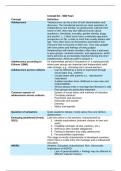Concept list – Wild Years
Concept Definition
Adolescence “Adolescence can be a time of both disorientation and
discovery. The transitional period can raise questions of
independence and identity; as adolescents cultivate their
sense of self, they may face difficult choices about
academics, friendship, sexuality, gender identity, drugs,
and alcohol. (…) Most teens have a relatively egocentric
perspective on life; a state of mind that usually abates with
age. They often focus on themselves and believe that
everyone else is focused on them too. They may grapple
with insecurities and feelings of being judged.
Relationships with family members often take a backseat
to peer groups, romantic interests, and appearance, which
teens perceive as increasingly important during this time.”
(Adolescence, 2020) as used in Lecture 1.
Adolescence according to An intermediate period of moratorium (= a waiting period)
Erikson (1980) where peer groups are important and independent adult
roles emerge, e.g., choosing one’s sexual partners.
Adolescence across cultures - Can be defined by a word or expressed through
visual signs (e.g., clothes)
- Usually starts with puberty (i.e., reproductive
maturation)
- Sudden transition from childhood to new roles and
responsibilities
- Almost always ends in marriage (but literature is old)
- Peer groups are particularly important
Common aspects of - System of social status and methods of indication
adolescence across cultures - Courtship practices
- Psychoses and neuroses
- Homocide and suicide
- Dancing
- Myths and legends
- …
Question of semantics Quite academic debate; mostly about how one defines
adolescence.
Emerging adulthood (Arnett, Late teen years to mid twenties; characterized by:
2015) 1. Identity explorations (relevant choices in love and
work)
2. Instability (changes of jobs, partners, etc.)
3. Self-focus (few outside obligations)
4. Feeling in-between (not really adolescent)
5. Felt possibilities (optimistic)
This stage is mostly characteristic of developed countries,
where there is a late entry into marriage and a widespread
education.
WEIRD Western, Educated, Industrialized, Rich, Democratic
Implications of WEIRD:
- Lack of generalizability = findings may be different in
different cultural contexts.
, - Wrong conclusions = if we assume that all people
are like participants in our research.
- Interventions may not work or even be
counterproductive if we apply them in other
contexts.
- Scientific colonialism = scientific norms are imposed
on other contexts than the WEIRD ones.
- We may incorrectly categorize people based on
WEIRD standards.
Iatrogenic effects An adverse effect caused by an intervention.
Positionality All the characteristics making up who you are and how you
view the world, e.g., sociodemographic characteristics,
beliefs, values, experiences…
Reflexivity The influence of one’s positionality on the research
process and interpretations of research outcomes (i.e., on
choice of topics, on what is considered desirable, on
interpretation of results, …)
Culture Intersubjective understanding of culture.
“Culture is an evolved constellation of loosely organized
ideas and practices that are shared (albeit imperfectly)
among a collection of interdependent individuals and
transmitted across generations for the purpose of
coordinating individual goal pursuits in collective living.”
(Chiu, Leung & Hong, 2010) or the easier version of this:
Culture is a set of ideas and practices that develop over
time, shared among a group of people, and passed down
through generations. It helps individuals work together to
achieve their individual goals in a community.
Individualism - Prioritizing own aims/values.
- Valuing being independent.
- Focus on more transient chosen relationships (e.g.,
friendships, romantic relationships).
- More people live alone more common to live in
nuclear families or only with partner than multi-
generation households.
Collectivism - Prioritizing group’s aims/values.
- Valuing interdependence between people.
- Focus on stable assigned relationships (i.e., family).
- More people live together with family more
people live in multi-generation households.
Social norms What is typically done or ought to be done?
Values What is desirable and important?
E.g., family, wealth, stability, etc.
Beliefs What do people perceive to be true?
E.g., “A love-based marriage is more fulfilling than an
arranged marriage”.
Descriptive norms Unwritten rules about what most people do.
E.g., “Most adolescents have had a romantic partner when
they are 18”.
Prescriptive/injunctive Unwritten rules about what people should do.




